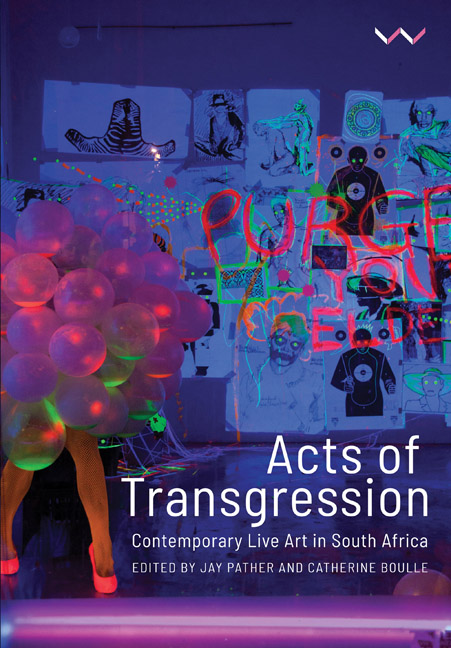Book contents
- Frontmatter
- Contents
- Acknowledgements
- Introduction
- PART ONE LIVE ART IN A TIME OF CRISIS
- 1 Artistic Citizenship, Anatopism and the Elusive Public: Live Art in the City of Cape Town
- 2 Upsurge
- 3 ‘Madam, I Can See Your Penis’: Disruption and Dissonance in the Work of Steven Cohen
- 4 The Impossibility of Curating Live Art
- PART TWO LOSS, LANGUAGE AND EMBODIMENT
- PART THREE RETHINKING THE ARCHIVE, REINTERPRETING GESTURE
- PART FOUR SUPPRESSED HISTORIES AND SPECULATIVE FUTURES
- Contributors
- List of Illustrations
- Index
4 - The Impossibility of Curating Live Art
from PART ONE - LIVE ART IN A TIME OF CRISIS
Published online by Cambridge University Press: 30 May 2019
- Frontmatter
- Contents
- Acknowledgements
- Introduction
- PART ONE LIVE ART IN A TIME OF CRISIS
- 1 Artistic Citizenship, Anatopism and the Elusive Public: Live Art in the City of Cape Town
- 2 Upsurge
- 3 ‘Madam, I Can See Your Penis’: Disruption and Dissonance in the Work of Steven Cohen
- 4 The Impossibility of Curating Live Art
- PART TWO LOSS, LANGUAGE AND EMBODIMENT
- PART THREE RETHINKING THE ARCHIVE, REINTERPRETING GESTURE
- PART FOUR SUPPRESSED HISTORIES AND SPECULATIVE FUTURES
- Contributors
- List of Illustrations
- Index
Summary
The performance by Mamela Nyamza, which marked her status as the 2011 Standard Bank Young Artist for Dance at the National Arts Festival, was curated in a venue featuring a rectangular stage framed by black curtains, black dance mats, raised seating, and lights and sound that were controlled from the back of the massive auditorium. An ideal setting for viewing dance. Or not. Because, at that juncture, Nyamza was not performing dance in the conventional sense, or as the typical stage set-up accommodated. The work – intense and impeccably crafted – was gestural and minimal in its physicality. Entitled Amafongkong (an isiXhosa slang word for fake merchandise imported from China), the performance occupied that provocative space between radical dance work and live art collaboration (with the Adugna Dance Company, a company of mixed-ability performers from Ethiopia). Through acerbic satire, Amafongkong evoked a continent under constant siege by a voracious global economy, critiquing the persistence of poverty, unemployment and economic crisis in the guise of development through global investment. Devoid of the kind of narcissistic technical virtuosity that characterises much conventional dance, this razor-sharp work required a critical, contemplative audience. The audience needed to sit considerably closer than is generally required for dance performances and made possible by the auditorium space.
As a result of this blind spot in communication and assumptions made in the curation of the work, chaos ensued in the lead-up to its premiere. In a matter of hours, the audience seating, technical control and stage management all had to be moved and recalibrated. The audience was now to be placed on stage and the very large raised seating area was covered in black plastic, resembling a morgue, and not without due significance: the work did put an end to expectations of an award-winning dancer and choreographer. When some audience members walked out – a predictable response to a work that disrupted several notions of dance – they could no longer slip away quietly. In this new intimate configuration, they had to cross the stage to reach the exits and then walk ‘backstage’ where cast members with chopsticks in their hair were eating Chinese takeaways – Nyamza's comment on new imperialisms in Africa.
- Type
- Chapter
- Information
- Acts of TransgressionContemporary Live Art in South Africa, pp. 82 - 104Publisher: Wits University PressPrint publication year: 2019



